Is wholesale worth trying? Does wholesale actually work? Is it possible to make money with wholesale in 2020? How do I find wholesale suppliers to work with?
These are the types of questions I’ve been getting on a regular basis, especially since I’ve been talking about wholesale more and more over the past year – including the intro guide I recently published.
In this post, I’m going to do my best to answer all these questions by giving you a more in-depth look at the role of wholesale in my business right now.
I’ll also give you some sales numbers for an account we just added this year to give you an idea of what is possible.
NOTE: Our next Wholesale Accelerator is starting January 2021. Learn more here.
The Current Role Of Wholesale in My Business
To get right to the heart of it, we’ve been investing an increasing amount of time and energy into wholesale.
The returns we’ve been seeing are excellent – so much so that wholesale has grown to the point that it has provided over 65% of our sales over the last 30 days.
This isn’t just long-standing accounts either – we are continually reaching out to and adding new accounts. Like I mentioned above, I’ll go over some specific numbers for an account we just added in the last couple months at the end of this post.
What about retail arbitrage?
If you have been reading posts here on Online Selling Experiment for the past few years, you might be surprised to hear that over 65% of the sales for my business are now coming from wholesale.
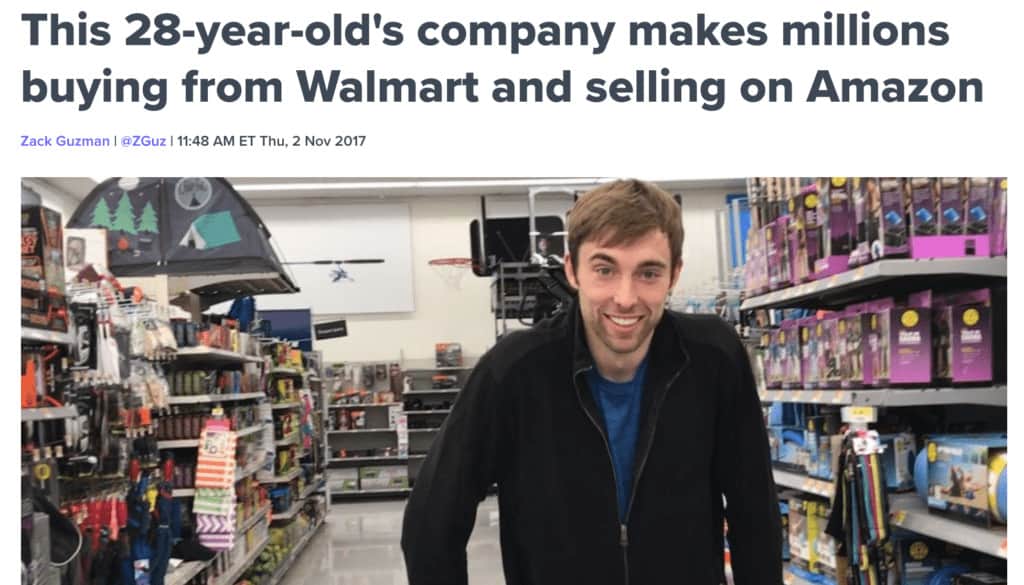
Retail arbitrage – the sourcing strategy I am best known for and the main strategy I used to start my business – still works and is something we’re still doing. While 65% of our sales over the past 30 days came from wholesale, the other 35% have come from retail arbitrage.
If you aren’t familiar, you can learn more about retail arbitrage here.
Wholesale becoming the majority of the inventory we buy has been a very gradual progression. We first started trying wholesale in 2014, and each year it has become a larger and larger percentage of sales. This is largely due to the rate of growth that we have seen from our wholesale products and the fact that wholesale has proven to be a much more scalable model than arbitrage.
But we’re not doing wholesale instead of retail arbitrage, and I’m not recommending it in its place.
If you’ve read about my Stairway to Seven Figures philosophy, then you know that I believe that the different sourcing methods like flipping, retail arbitrage, wholesale, and private labeling can and should be used together to help you build your business.
So now let’s talk about some of the reasons wholesale sourcing has grown to this level in my business, and then I will share the example of one account we are working with that I mentioned above.
Benefits of Sourcing Via Wholesale for Amazon FBA
Throughout this section, we’ll dive into some of the things that you are likely to find the most appealing about adding wholesale to your business.
- You can sell the same product over and over again.
- Wholesale makes it easier to manage inventory.
- Wholesale is easier to scale.
- Your existing suppliers will often add new products (that you can sell).
- The “Wholesale Snowball Effect”
You Can Sell The Same Product Over and Over Again
If you have experience sourcing via retail arbitrage, you know the thrill of finding an amazing deal on inventory that will make you a sizable profit. You send the inventory into Amazon FBA warehouses, and the sales come rolling in. You can hear the cha-ching of the register calculating your profits on each sale that comes in. But then something unfortunate happens.
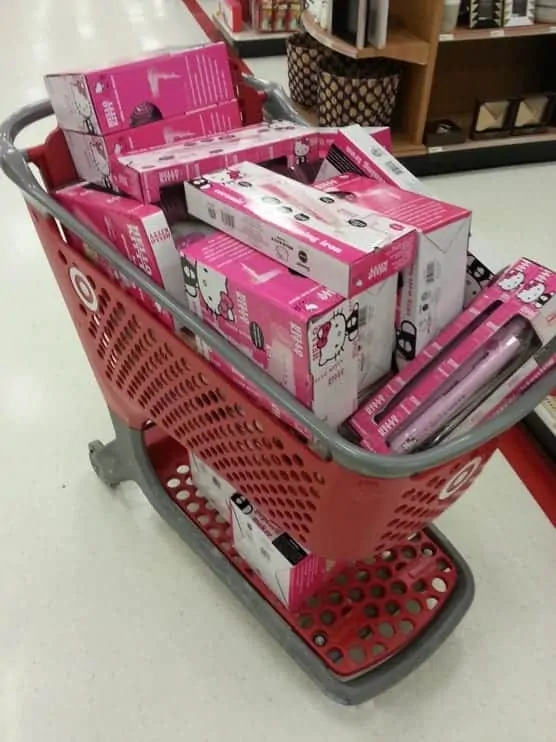
You run out of inventory!
No more cha-chinging of the register on this product. It’s time to get back out to the retail stores and find some more items that you can sell.
I am very familiar with this process. Retail Arbitrage has been a huge part of my business since before I quit my job as an accountant in 2013. There are parts of retail arbitrage that I love, but not being able to find more of a product that is selling well is not one of my favorite parts.
Enter wholesale sourcing.
With wholesale, when we are running low on inventory, we simply contact our suppliers and order more products. This means we rarely run out of stock on a product, and rarely can’t get more of a product that is selling well. This is a much, much better feeling than running out completely with no potential to get the product again!
This means that we are able to find a product once and then sell it indefinitely. We have wholesale accounts we opened in 2014 that we still buy from today. And in some cases, we have been selling the same products the whole entire way!
So we found a product once, and then have been able to sell that same exact product consistently for over 5 years!
Needless to say, the return on time spent finding those suppliers has been very high.
Now not every account that we’ve opened has been good for over 5 years. But it’s rare that we have opened an account and haven’t ended up placing multiple reorders from it.
Being able to source the same products over and over again is my favorite part about sourcing via wholesale. My guess is that it will be yours too.
Wholesale Makes it Easier to Manage Your Inventory
When running an inventory based online retail business, managing your in-stock levels and how quickly you are selling product is essential. If you don’t manage your inventory levels properly then you will run into many problems.
The biggest is getting into a challenging cash flow situation. The other noteworthy one is paying too much in storage fees for items stored in Amazon FBA warehouses.
Fortunately, with wholesale we are able to keep a relatively consistent supply of product on hand. We can look at our sales over the past 30 days (or whatever time period you choose) and then use that to forecast what your sales will be for the next 30 days. If you don’t have enough inventory, you can order more from your supplier.
For most wholesale accounts that we work with in my business, we aim to have about a 45-day supply of inventory. This means that we are selling through our entire inventory about 8 times per year on our wholesale products. This allows us to compound our returns very quickly.
For a simplistic example of these compounded returns, if you start with $10,000 and sell through your inventory completely 8 times per year, while seeing a 25% ROI every time you sell through your inventory, you will have about $47,683 at the end of the year.
If you sell through your entire inventory more than 8 times in the year or have a higher ROI you could turn this into even more. And the reverse is also true, if you have a lower ROI, or sell through your inventory less than 8 times in the year, then you would end up with less.
The beauty of wholesale is that you can look at your past rate of sales to predict your future rate of sales. This gives you a very good idea of how much to purchase at a given time. This leads to maximizing the use of the cash you have available in the business and minimizes the storage fees that you pay for your items.
Wholesale is A More Easily Scalable Sourcing Model
Another reason I like sourcing via wholesale is that it is easier to scale. If the product is selling well, I can simply let our suppliers know and order more. They will then ship all of the product to my location.
Whether I am ordering 6 of each item, or 100s of each item, the time it takes to place the order is about the same. The only real change comes into play with how long it takes to prep and ship the items to FBA warehouses.
With the ordering process being about the same amount of time regardless of the number of units, it allows for my business to scale up orders without scaling up the team proportionately. Whereas with retail arbitrage if we want to buy more product it will take more time and space in our vehicles, that same constraint does not exist when it comes to wholesale.
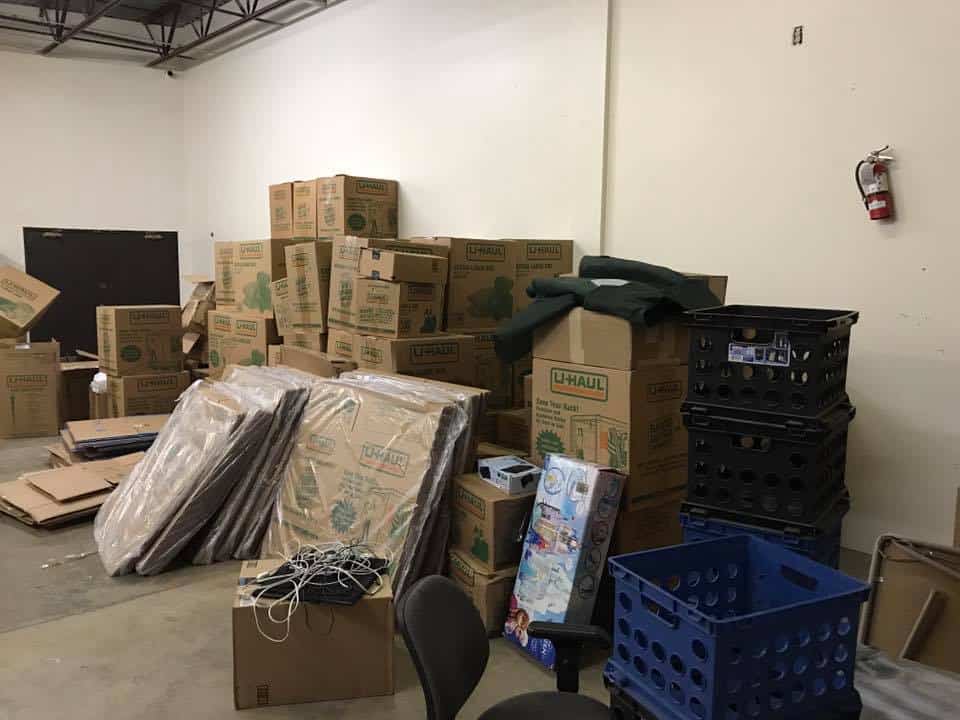
If you decide to use a prep center or 3rd party logistics company for your inventory, then you do not have to worry about scaling your team to get inventory out the door either. Your prep center will worry about that part. You will obviously pay them per unit, but it doesn’t require any additional time on your end.
As a result of these factors with wholesale, you can grow the amount you are purchasing very quickly without adding a lot of time on an ongoing basis.
The Number of Products You Sell Can Grow With Your Suppliers
When it comes to wholesale, many of the suppliers you work with will introduce new products to market over time.
If you are doing a good job representing the other products they carry, you will likely have the ability to sell the new products they release. This means that you will be able to grow the number of products you sell and are making profits on as your suppliers release more products.
This has happened with many of the suppliers we work with. They will introduce new products, and we are able to carry them right away. It allows us to expand our selection (and what we are making money on) with barely any additional work.
The Wholesale Snowball Effect
The final reason that I will mention on why I love sourcing via wholesale is what I am calling the “Wholesale Snowball Effect”.
When you first get started with wholesale it can be a bit slow going. It takes time to build relationships and find suppliers that are willing to work with you.
But over time, as you work with more and more suppliers, you are able to leverage your existing suppliers into more suppliers. This can be done both by asking your existing suppliers for intros to others in their industry and also by leveraging the names of the suppliers you work with.
Leveraging the name of an existing subscriber is essentially “name dropping”. Let’s say for example you currently have a wholesale relationship with Adidas, and you are looking to open up an account with Nike.
You can go to Nike and say, “We’d really love to carry your products. We’re currently doing some great volume with Adidas products, and I think we can do the same with yours…”
Saying something along these lines helps to establish your credibility. It also gets the supplier that you aren’t working with to think they might be missing out on something by not working with you. This then leads to you having a higher potential to be able to work with the new potential supplier.
The point here is that the initial hard work required to get started with wholesale REALLY pays off the longer you do it. It can be slow going when you are getting started, but as you get more established the results you will see are very likely to snowball.
Case Study: A Wholesale Account We Started This Year And Are Already Making $1,000+ Per Month On
As promised in the intro, I am going to share some of the details of one of the wholesale accounts we currently work with, and how the setup process worked.
We reached out to the supplier in February 2019 to see about the potential of working with them. We went back and forth with them, provided some info regarding how we thought we could help, and ultimately we reached an agreement to work together.
At the beginning of March, we completed all of the account setup forms and analyzed the price list for their products. We found 8 unique products that we wanted to buy. We bought 96 items across products for a total cost of $684.
We received the product the second week of March and shipped the product out of our location to FBA warehouses on March 14th.
4 days later on March 18th, we had our first sale from this purchase! And we found that the sales kept coming. The sales were coming in so quick that we were out of some of the products within a week of them being for sale.
This meant it was time to order more product. We bought a lot more quantity of the products that were selling well, and also bought some additional products this company sold that we thought would do well.
We placed an order at the beginning of April for 328 total items for a cost of $3,128. This was almost 5 times what our original order was since we were able to see the demand for these items.
This second order has continued to sell well, and we’ve since placed additional orders from this supplier. Over the past 30 days on the items we have sold, we have made a gross profit of $1,294 from this account on $5,093 in sales! And we still have more product in stock that will continue to sell and generate profits.
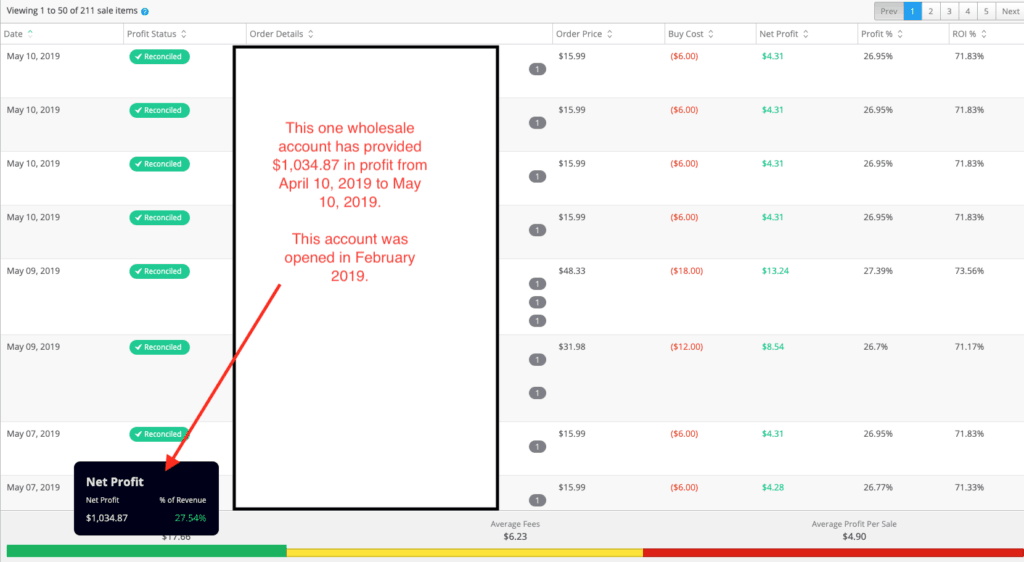
We have now had this account opened for less than 3 months, and it’s already averaging over $1,000 per month in gross profit.
I don’t believe that’s anywhere close to the potential we’ll see on this account. We should be able to scale the orders from this supplier up based on our sales, and I think we have the potential to make over $2,500 per month in gross profit from this one supplier.
This account is also in a brand new category that we don’t have any other wholesale accounts in. We were starting from scratch in this category and weren’t able to take advantage of the “wholesale snowball effect” I mentioned above.
If we can open accounts like this in a category we don’t have experience with, then there’s no reason that you can’t do the same.
The Power of Outsourcing and Teams
And one final note, I didn’t even know my business had this account until the sales were rolling in from this supplier.
My team found this account, did all the work to set it up, placed the initial order, and did everything necessary to get the product listed and selling.
That’s the beauty of having a great team and great systems.
You won’t be able to get to the point of having a team do all of this for you overnight. This has been over a 5-year journey for me to get to this point. But I wanted to point this out in case you found it inspiring. Because if you put in the work, there’s no reason you can’t build something similar.
Get Your First Wholesale Account
If you are interested in setting up wholesale in your business, make sure you check out our Wholesale Accelerator program.
Participants work closely with my team and I to get their first account and place their first order.
We hold these about once per quarter. You can get more details here.
Questions?
If you have any questions or comments, please share them in the comment section below.

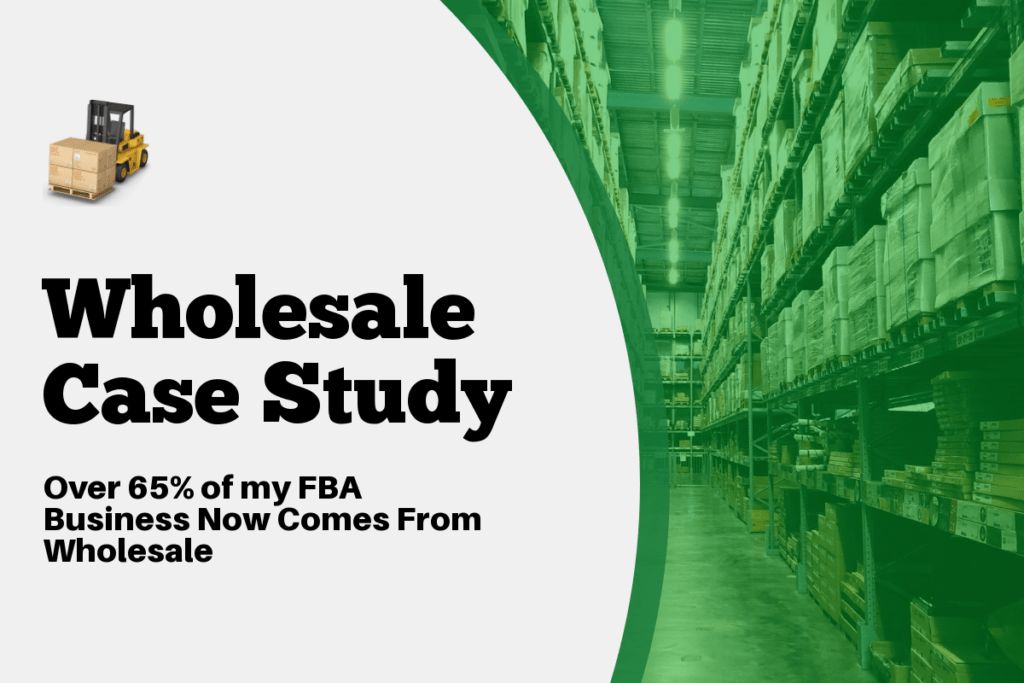
Somewhere in your free material you mention having suppliers or possibly a third party that store, pack and ship items to the FBA facility. I can’t seem to find where it was written and it’s driving me crazy! Can you help me find that info and possibly more on the subject?
Hi Dave,
It sounds like you are referring to a prep center. Here’s a link to our free Amazon FBA prep center directory.
There’s also some information in the post about how to pick one that makes sense for your business. Hope that helps!
Best Regards,
Ryan